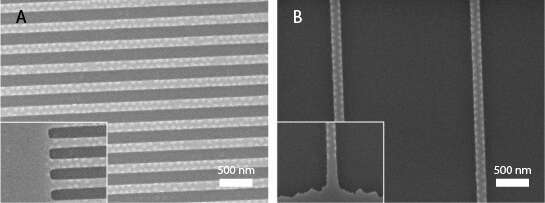
Highly ordered, complex morphologies in block copolymer films obtained by spatial confinement using topographical substrates
2Institute for Theoretical Physics, Georg-August-Universität Göttingen, Göttingen, Germany
3Department of Materials Engineering, Ben-Gurion University of the Negev, Beer-Sheva, Israel
Block copolymers microphase separate into periodic arrays of nanostructures. Thin films of these self-assembled BCPs are finding increasing use as platforms for nanofabrication, either as lithography masks or as templates for the patterning of nanowires and particles. Directed self-assembly, using a chemical or topographical pre-pattern, increases the long range order of BCP thin films and can be used to introduce diversity to the BCP morphology. However, the ability to pattern BCPs in a variety of morphologies in close confinement usually requires multiple fabrication steps and is limited in scope.
We present a simple, one-step process for obtaining complex, highly ordered morphologies in ultra-confined films in a controlled fashion. Our approach utilizes topographically patterned silicon substrates to guide the assembly of block copolymer domains. Remarkably, different local morphologies of the block copolymer are observed on the plateaus and inside the trenches. This behavior is explained in terms of the variation in the local film thickness and the selectivity of the substrate towards one of the copolymer domains.

Thin films of PS-b-PMMA on topographically patterned substrates. A. 160 nm wide plateaus separated by 160 nm wide trenches show dot patterns on the plateau and lying lamellae morphology in the trenches. B. 160 nm wide plateaus separated by 2 µm wide trenches show similar pattern, separated by larger trenches. Insets show the edge of the topographical pattern, same magnification.
Powered by Eventact EMS